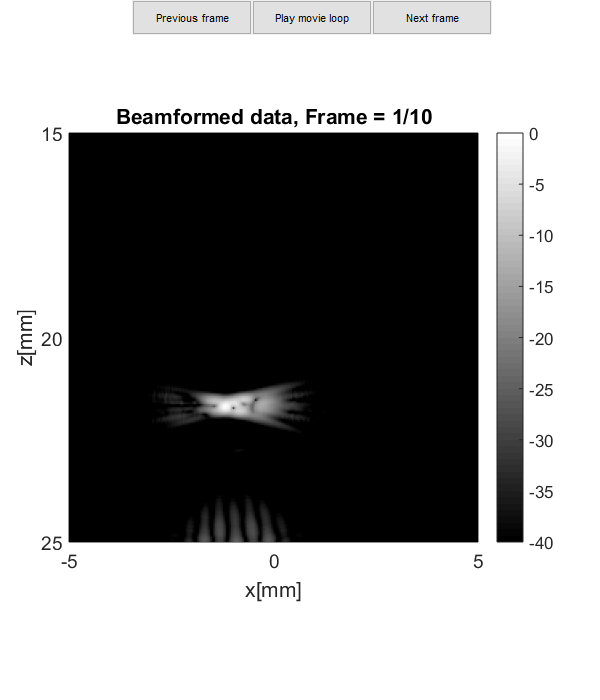Contents
CPWC movement simulation with the USTB built-in Fresnel simulator
In this example we show how to use the built-in fresnel simulator in USTB to generate a Coherent Plane-Wave Compounding (CPWC) squence on a linear array and simulate movement.
Related materials:
by Alfonso Rodriguez-Molares alfonso.r.molares@ntnu.no 13.03.2017 and Arun Asokan nair anair8@jhu.edu
clear all; close all;
Phantom
Our first step is to define an appropriate phantom structure as input, or as in this case a series of phantom structures each corresponding to the distribution of point scatterers at a certain point in time. This distribution is determined by the variables defined below.
alpha=-45*pi/180; % velocity direction [rad] N_sca=1; % number of scatterers % x_sca=random('unif',-10e-3,10e-3,N_sca,1); % Uncomment this if using % multiple scatterers % z_sca=random('unif',15e-3,25e-3,N_sca,1); % Uncomment this if using % multiple scatterers x_sca=-1e-3; % Comment this out if using multiple scatterers z_sca=21e-3; % Comment this out if using multiple scatterers p=[x_sca zeros(N_sca,1) z_sca+x_sca*sin(alpha)]; v=0.9754*ones(N_sca,1)*[cos(alpha) 0 sin(alpha)]; % scatterer velocity [m/s m/s m/s] PRF=10000; % pulse repetition frequency [Hz] N_plane_waves=3; % number of plane wave N_frames=10; % number of frames fig_handle=figure(); for n=1:N_plane_waves*N_frames pha(n)=uff.phantom(); pha(n).sound_speed=1540; % speed of sound [m/s] pha(n).points=[p+v*(n-1)/PRF, ones(N_sca,1)]; % point scatterer position [m] pha(n).plot(fig_handle); end
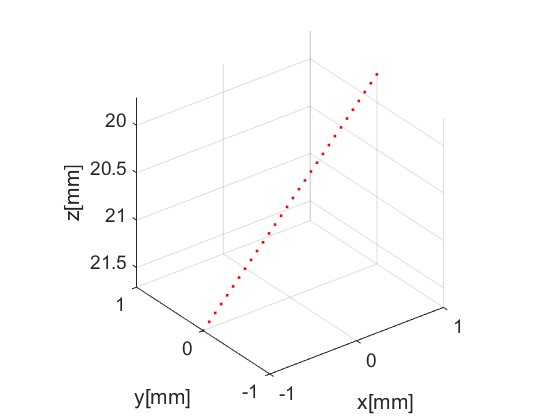
Probe
The next step is to define the probe structure which contains information about the probe's geometry. This too comes with % a plot method that enables visualization of the probe with respect to the phantom. The probe we will use in our example is a linear array transducer with 128 elements.
prb=uff.linear_array(); prb.N=128; % number of elements prb.pitch=300e-6; % probe pitch in azimuth [m] prb.element_width=270e-6; % element width [m] prb.element_height=5000e-6; % element height [m] prb.plot(fig_handle);
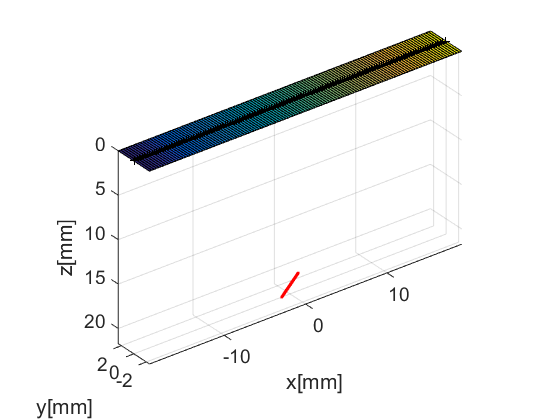
Pulse
We then define the pulse-echo signal which is done here using the fresnel simulator's pulse structure. We could also use 'Field II' for a more accurate model.
pul=uff.pulse(); pul.center_frequency=5.2e6; % transducer frequency [MHz] pul.fractional_bandwidth=0.6; % fractional bandwidth [unitless] pul.plot([],'2-way pulse');
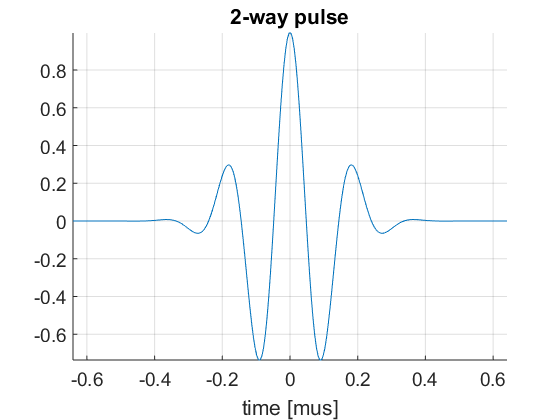
Sequence generation
Now, we shall generate our sequence! Keep in mind that the fresnel simulator takes the same sequence definition as the USTB beamformer. In UFF and USTB a sequence is defined as a collection of wave structures.
For our example here, we define a sequence of 15 plane-waves covering an angle span of ![$[-0.3, 0.3]$](CPWC_linear_array_multiframe_eq14339125197225071258.png) radians. The wave structure has a plot method which plots the direction of the transmitted plane-wave.
radians. The wave structure has a plot method which plots the direction of the transmitted plane-wave.
angles=linspace(-0.3,0.3,N_plane_waves); seq=uff.wave(); for n=1:N_plane_waves seq(n)=uff.wave(); seq(n).source.azimuth=angles(n); seq(n).source.distance=Inf; seq(n).probe=prb; seq(n).sound_speed=pha.sound_speed; % show source fig_handle=seq(n).source.plot(fig_handle); end
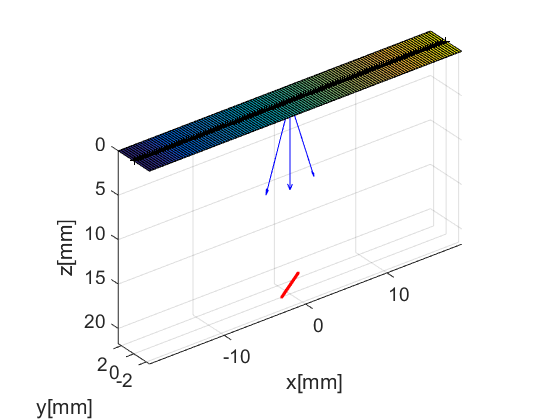
Simulator
Finally, we launch the built-in fresnel simulator. The simulator takes in a phantom, pulse, probe and a sequence of wave structures along with the desired sampling frequency, and returns a channel_data UFF structure.
sim=fresnel(); % setting input data sim.phantom=pha; % phantom sim.pulse=pul; % transmitted pulse sim.probe=prb; % probe sim.sequence=seq; % beam sequence sim.PRF=PRF; % pulse repetition frequency [Hz] sim.sampling_frequency=41.6e6; % sampling frequency [Hz] % we launch the simulation channel_data=sim.go();
USTB's Fresnel impulse response simulator (v1.0.5) ---------------------------------------------------------------
Scan
The scan area is defines as a collection of pixels spanning our region of interest. For our example here, we use the linear_scan structure, which is defined with just two axes. scan too has a useful plot method it can call.
sca=uff.linear_scan(linspace(-5e-3,5e-3,256).', linspace(15e-3,25e-3,256).'); sca.plot(fig_handle,'Scenario'); % show mesh
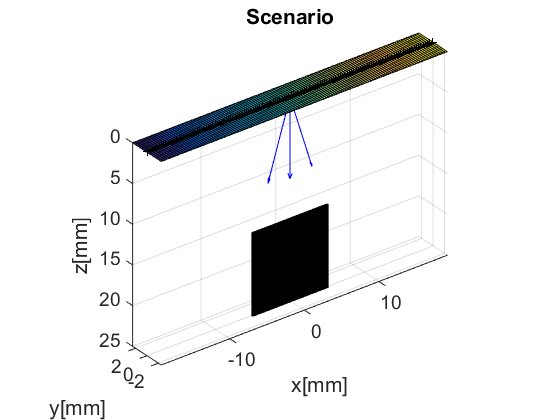
Beamformer
With channel_data and a scan we have all we need to produce an ultrasound image. We now use a USTB structure beamformer, that takes an apodization structure in addition to the channel_data and scan.
bmf=beamformer(); bmf.channel_data=channel_data; bmf.scan=sca; bmf.receive_apodization.window=uff.window.tukey50; bmf.receive_apodization.f_number=1.0; bmf.receive_apodization.apex.distance=Inf; bmf.transmit_apodization.window=uff.window.tukey50; bmf.transmit_apodization.f_number=1.0; bmf.transmit_apodization.apex.distance=Inf;
Go beamformer! % The beamformer structure allows you to implement different beamformers by combination of multiple built-in processes. Here, we shall use delay-and-sum (implemented in MATLAB); there is a MEX implementation too that we could call with process.das_mex(). In addition, we shall chain it with the process.coherent_compounding() to coherently compound the individual plane wave images.
b_data=bmf.go({process.das_matlab() process.coherent_compounding()});
Finally, show our results
b_data.plot([],['Beamformed data'],40);
